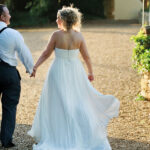
Exploring Our Planet Through Sound with Thomas Rex Beverly
Posted on Jun 16, 2023 by Pro Moviemaker
Beverly used some additional MKH 8020 mics supplied by Sennheiser specially for the Greenland expedition in spaced omni set-ups in various configurations, recording the calving of glaciers, icebergs breaking up and other unique sounds. “Apart from my Sennheiser double mid-side rig, I now also have four MKH 8020s, which I can use in spaced omni set-ups, so I’ll either use them in stereo pairs or in Quad.
For ambiance recording, for example, Beverly explains that he prefers the sound of spaced omnis, for which the MKH 8020 is perfect. As well as his Sennheiser set-up, Beverly also uses multiple recorders, hydrophones for underwater recording, and Geofones, “which are basically contact microphones that I can stick into the glacier to record some of the sub-bass sounds,” he adds.
Sound recordist Thomas Rex Beverly uses Sennheiser gear to capture calving glaciers, underwater icebergs, and an ice xylophone in Greenland
Thomas Rex Beverly’s 90 plus nature sound libraries have been used extensively in the world of television, games, apps, museum exhibits and on high-profile film productions such as CODA, The Last of Us, Jack Ryan, Star Trek: Picard, Yellowstone, and Frozen II. As a nature sound recordist and composer with over ten years of experience, Beverly explores our evolving planet through sound. Through his field recordings, music, and sound art, he inspires listeners and hopes to help preserve the precious natural landscapes and their breath-taking soundscapes for future generations.

Beverly’s loyal companions on his past three successful arctic expeditions to Alaska (2019), Iceland (2021) and Norway (2022) have been Sennheiser MKH 8020, MKH 30, and MKH 8040 microphones as well as HD 280 PRO headphones. His fourth and latest major expedition took him to Greenland in 2022. This journey was part of Beverly’s project of recording and preserving the sounds of endangered species and ecosystems, including the thunderous calving of glaciers and underwater sounds of whales and other marine wildlife.

The unfolding of a journey
“I actually studied Music Composition in college,” says Beverly. “During that time, I used to write a lot of contemporary classical music, choir music, orchestra music, chamber music, etc. Then I completed a master’s degree in music composition and music technology, as well as audio engineering. That got me more into the recording side of music production, and taught me how to record with microphones in a studio setting.
“Eventually, I started taking the microphones outside to record sounds of nature that I would incorporate into my own musical pieces.” These recorded sounds sometimes became part of a sound art installation in a museum, a live performance piece, or an electroacoustic work of just natural sounds.
Some years later, when he was on track to get a doctorate in music composition and to become a university professor, he decided to move away from academia and, instead, use the skills he had learned as a composer and audio engineer for full-time outdoor nature recording. “Apart from traditional recording techniques, I had also developed some of my own recording methods to suit my long-duration recording sessions. The interest in field recording mostly came out of my interest in writing my own music, so it just evolved from there,” he explains.
For the last eight years, Beverly has focused on field recording, with a particular passion for recording nature sounds. “I have always enjoyed being outdoors, hiking, backpacking, or mountaineering. Field recording has allowed me to combine my passion for nature and my passion for recording. Another important part of my work is in the studio editing – there’s always a minimum of three days editing for one day of outdoor recording,” Beverly shares.
With him in his nature adventures is a pair of closed Sennheiser HD 280 PRO headphones. “I’ve been using them for a long time, as they offer a flat frequency response across the spectrum and great isolation. HD 280s also hold up well outside, and I’m usually in extreme temperatures with a lot of humidity. I love the isolation as it allows me to monitor while being in the field.”

Apart from the HD 280 PRO, Beverly’s main recording rig comprises a double mid-side set-up with a Sennheiser MKH 30 figure-of-eight and two Sennheiser MKH 8040 cardioid condenser microphones.
“You have a front and a rear mic, which in my case is a pair of 8040s, and the side mic is an MKH 30. This has been my ‘go-to’ rig, as you can do everything from a close-up animal recording to recording surround sound, all in one blimp. Plus, it’s a compact rig, which is important for me as I always have to think about how much gear I can actually fit in my backpack. Another benefit of a rig like this is that Sennheiser mics do really well in extreme temperatures and humidity. After having them for over six years, recording in the wild at least eight weeks of the year, they are still going strong!”

Beverly used some additional MKH 8020 mics supplied by Sennheiser specially for the Greenland expedition in spaced omni set-ups in various configurations, recording the calving of glaciers, icebergs breaking up and other unique sounds. “Apart from my Sennheiser double mid-side rig, I now also have four MKH 8020s, which I can use in spaced omni set-ups, so I’ll either use them in stereo pairs or in Quad.
For ambiance recording, for example, Beverly explains that he prefers the sound of spaced omnis, for which the MKH 8020 is perfect. As well as his Sennheiser set-up, Beverly also uses multiple recorders, hydrophones for underwater recording, and Geofones, “which are basically contact microphones that I can stick into the glacier to record some of the sub-bass sounds,” he adds.

The fourth major expedition: Greenland
Explaining why he chose Greenland as his fourth major expedition destination, Beverly says it all started with his first trip to Alaska: “I went there and just fell in love with the Arctic. I love wide, open spaces. That comes from my childhood; I grew up in the Southwestern part of the United States where there are lots of mountains, big wide open desert and landscapes. You get a lot of that in the Arctic as well, plus, you get the glaciers, which are fascinating. I’d seen my first glaciers in Alaska and Iceland, but before Greenland had not explored them up close.
“There has been a lot of emphasis put on documenting receding glaciers– from time-lapse photography to documentary footage – but every time I’ve seen videos of these huge calving events, the audio was just below average. Often it would be just off-the-camera sound, or even no audio at all. I wanted to capture those sounds and share them with others.”
Greenland is renowned for its glaciers of all sizes across the island, with its ice sheet being the second biggest after Antarctica. Having such an abundance of beautiful arctic landscapes offered Beverly a perfect opportunity to record the unique sounds of the calving glaciers, underwater icebergs, ‘ice xylophones’, ice caves – and also a ‘mega-pack’ of 250 sled dogs howling at the arctic moon.
“Greenland is a magical place to record those sounds,” Beverly shares. “With a population of just 60,000, mostly concentrated on the country’s southwest coast in the capital, Nuuk, there is very little tourism on the Eastern side of the country, so you can get to really remote areas no human has ever set foot on, which was an amazing experience!”

Recording stories: sled dogs
Beverly flew from New York to Iceland’s capital Reykjavik and then travelled on to Kulusuk in Greenland. Kulusuk is a settlement in Southeastern Greenland, located on an island of the same name. Beverly arrived in July, during the days of the midnight sun.
In addition to about 200 people, the little village of Kulusuk is home to 250 sled dogs! Sled dogs are a large part of the local culture in Kulusuk and act as transportation across the sea ice during the tough Greenlandic winter.
“One lifetime ago, the winter sea ice lasted for seven or eight months. Nowadays, the sea ice is solid for only four to five months, which means that during the warmer months the dogs are not used. Then, using boats, the owners must hunt seals in order to feed the large number of dogs,” says Beverly. “The reduction in sea ice due to the warming climate sadly means that many people are considering getting rid of their dogs because they are used for fewer months each year. If that goes down to three of four months, it is likely this part of the East Greenlandic culture will be lost. Greenlanders will use boats instead for transportation, fishing, and hunting for the majority of the year.”
Beverly first experienced the mega-pack of sled dogs howling at about 2:00am on his first night in Kulusuk. “I’ve been woken up by coyotes while camping, but this was next level,” he recalls. “The volume and range of character within the megapack was fascinating!”

Describing the sound the dogs make, Beverly says they did not sound like domestic animals to his ears. “They have a tough, wild life in Greenland and sound more like something between a coyote and wolf. Imagine one wolf-like howl starts in the distance. Then another. Then another. The sound slowly daisy-chains down the fjord as one dog triggers another, until a giant megapack of 250 wolves is howling! The whole event takes 3-5 minutes and is immensely powerful to hear.” Sound Sample: https://soundcloud.com/trexbeverly/sled-dogs
Describing a sad instance when a mother dog died in her sleep while Beverly was recording, he says that once the owners had discovered the dog had died, they had to take the body away. “When they did that, the pack and her puppies realized what had happened and let out heart-breaking shrieks. The pack was so upset to lose one of its members and it was an intensely visceral sound. It was one of the saddest things I’ve ever recorded. Luckily the puppies were old enough to be bottle-fed and should survive,” he says.
As well as recording the full pack of sled dogs, Beverly also recorded smaller sled teams of eight to 12 dogs howling, as well as lonesome solo howls, playful duets, crying puppies, yips and barks, angry barks and snarls, and eerie resonant echoes.
Capturing the magnificent sounds of calving glaciers
Getting to the glaciers was not easy. It involved a two-hour boat ride from remote Kulusuk to travel even deeper into the Arctic. Here, he encountered ginormous glaciers such as the Knud Rasmussen and Karaale Glaciers. Only the large glaciers have names, but every small valley is filled with countless smaller unnamed glaciers.
“We would camp by the glaciers, then go back to Kulusuk to regroup for a few days, charge batteries, and then go out for another stretch,” he explains. “The recording conditions were nearly perfect, as the temperatures were fairly mild at around five to six degrees Celsius and, with the sun that never sets in July, it was handy to be able to record at any time of the day. Sometimes nothing happened for 12 hours, sometimes there was a flurry of activity over a one-hour timespan, so it was very important to get the audio right every time the calving activity took place.”
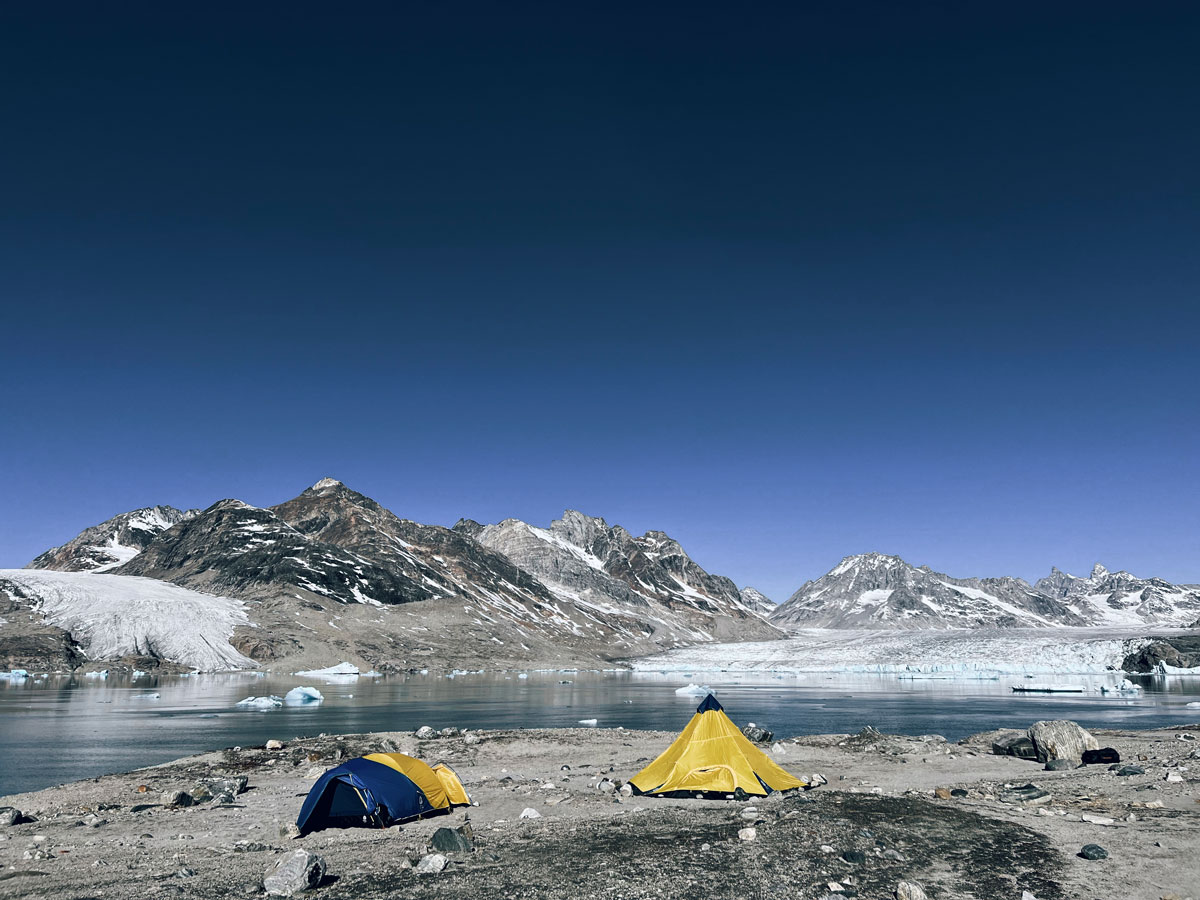
Whilst calving is not predictable, and only the glacier knows when it will move, according to Beverly weather and tides have an effect. Low tide in particular causes the floating tongue of the glacier to lose its support and, as a result, calving increases.
“Each glacier also has its own sonic personality,” says Beverly. “Karaale was about 1.5 km wide and the face was 10 to 15 metres tall. Knud was 2 km wide and was taller at about 30 metres. The width and height of the mountainous fjord also makes a big difference to the calving sounds, so the acoustics are different for each glacier. Karaale had more long roaring events as huge pieces broke loose and rolled. Knud had more thunderous gunshot-like cracks as pieces broke from the top and fell to dynamite the water below.”
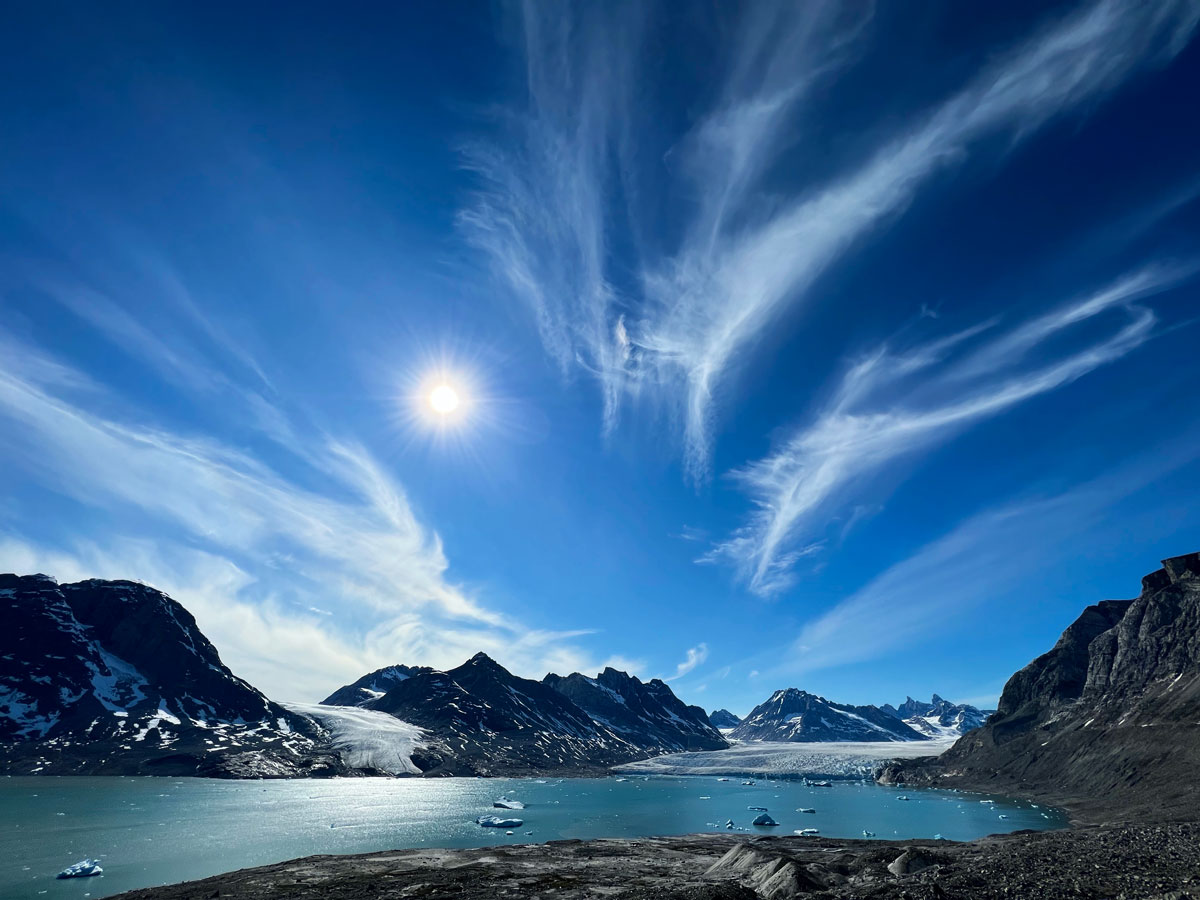
As Beverly was recording on three different glaciers, he had microphones placed on either side of the calving face as they would sound very different depending on what was happening with the glacier. He would have the microphones running almost continuously. Beverly had between five and eight audio recording rigs set up and running 24 hours a day for 14 days.
“I have some small, lavalier mics that I run off my handheld recorders, and those use plug-in power of about five volts and can run continuously for over five days,” he says. “Then I have my main Sennheiser double mid-side rig, which runs on 48-volt phantom power. The three mics I use – a pair of MKH 8040s and an MKH 30-P48 – can run for roughly 18 hours on one battery. Generally, we would camp somewhere near one of the glaciers, so I’d have the Sennheiser double mid-side rig near the campsite recording the calving. Over the two weeks, I managed to capture about 700 of the calving events, which was astonishing.”
Describing one interesting phenomena, Beverly explains how sometimes he would observe seabirds swarming to the water in front of the glacier after calving events. For a while, he could not figure out why they behaved this way. Then it dawned on him that if a big chunk fell from high up and smacked the water, it would stun the fish. “The glacier was dynamiting the fish and the seabirds had learned to listen! Gulls only responded to large booming events that they had learned would stun the fish. They didn’t flock to smaller avalanches that slushed off the face. It was a captivating feeding behaviour to witness!”
Another event Beverly refers to as ‘biblical’ took place when he was camped on the edge of the fjord next to the Knud Glacier. “I was in my tent, almost asleep, when I heard a deep rumble. I’d heard these many times before on the trip, but I felt this one in my bones and it wasn’t tailing off, it was continuing to build. I quickly ripped open the tent and saw a piece of ice the size of a skyscraper break off the glacier. It boomed and roared with incredible power. The calving event thundered continuously for five minutes! Then the fjord crackled and popped for the following four hours as the icy debris broke and released bubbles. It was an awe-inspiring and bittersweet moment that I will never forget.

Whilst calving is a natural behaviour of glaciers as gravity pulls the ice downhill, the rate of calving is increasing with climate change. “All of the glaciers I recorded in Greenland are currently retreating at an unprecedented rate. By recording the sounds of those spectacular calving events, I hope others can experience and love these living rivers of ice. The more people develop a visceral connection to the beautiful sounds of glaciers, the more likely we are to slow their retreat.”
From thunderous glacier calving events, to feeling the heartbeat of the glacier recorded with contact mics to massive booms, echoing gunshot-like cracks, reverberant rumbles, falling ice with explosive impacts and sub-bass thumps and pulses, Beverly managed to record events of small, large, massive and truly biblical sizes. Sound Sample: https://soundcloud.com/trexbeverly/greenland-calving-calving-glaciers
“Apart from calving, there’s lots of interesting stuff happening out on the glacier,” explains Beverly. “Together with my mountaineering guide, we put on crampons and went hiking. We also did some ice climbing and actually rappelled down into some of the big crevasses and listened to the sounds happening down in the glacier.”

Recording an ‘ice xylophone’
Here, Beverly found a fascinating natural phenomenon. “Occasionally, when glaciers split to create deep crevasses, thin flakes of ice still connect between walls. If you can find a crevasse with multiple flakes, a beautiful natural wonder occurs: the ice xylophone,” he explains. “It happens when you get ice on the top of the glacier called ‘sun crust’, similar to mojito ice made of tiny flakes. If you scrape those into crevasse with an ice axe something magical happens. The sun crust pings off the flakes on the way down with beautiful melodic tones! Each flake is a different size and at a different depth, so they have different audible pitches. The flakes function like little musical instruments that can be played by the ice.” Sound Sample: https://soundcloud.com/trexbeverly/greenland-ice-xylophone
Beverly jokes that his glacier guides, Nicco and Mike, became his foley artist, knocking the ice into crevasses while Beverly recorded the sound.
“It’s actually quite hard to find those spots, so this experience was unique,” he says. “The acoustics of large crevasses can be amazing. As the glacier moves, ice tears open in astonishing shapes and then meltwater sculpts it even further. These large crevasses reverberate like icy cathedrals, with intricate and complex reverbs unlike anything I’ve heard before in the natural world. Finding a crevasse with great reverberations is just as important as finding one with flakes connecting the walls.
“We captured natural icefalls by leaving drop rigs hanging in resonant crevasses for over 24 hours. This usually meant hanging the microphones over the edge by their cables and leaving the recorder in a dry bag on the edge, normally weighed down by a rock or clipped to an ice screw,” he says.
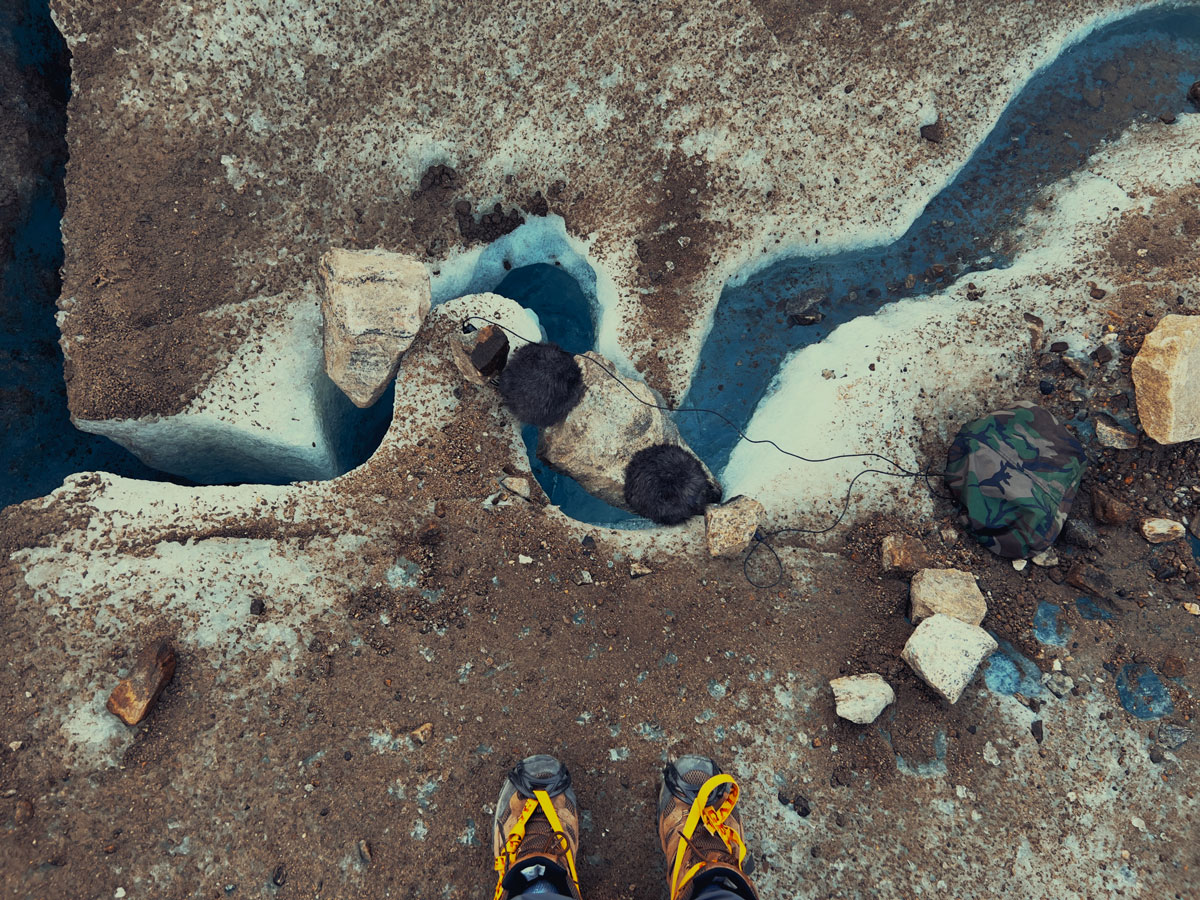
Discovering the ‘Ice Xylophone’ fed Beverly’s love for naturally occurring musical elements in the wild. “I was captivated by the melodic tones of this falling ice. These falling melodies are one of the ways the glaciers sing, but they also sing with droning melodic tones!
Ice caves
During the summer, glaciers are constantly melting. The meltwater carves ice caves with fascinating acoustic properties. Beverly hung his microphones deep into crevasses and rappelled down himself. “I’d make stereo bars out of selfie sticks, attach the mics and recorder (in a dry bag), and then drop the whole thing 25 metres down into a crevasse on a rope,” he says.
What he had discovered was beyond fascinating. “I realized that glacial crevasses actually sing! I thought I was hearing things at first, but then I realized that the water was sometimes resonating in ice caves to create a collection of droning pitches. These could be light and airy or very deep and ominous.”

While exploring the area, he started to feel pulsing bass vibrations in his chest. “I had my two MKH 8020s set up and two Geofones stuck into the glacier. Suddenly, I started feeling this bass sound, it sounded like a subwoofer. My guide and I wandered around for a bit before we found the source, a deep jagged crevasse that was home to what I called the ‘breath of the glacier’, formed by a large moulin [a waterfall inside the glacier] that was creating large pockets of air in the sub-glacier river. These bubbles would burst out every few seconds and the sounds would resonate up through the crevasse like a sleeping dragon. It was wild!”
Luckily, Beverly was able to record the entire event, which only happened for 20 minutes. “I even left the rig overnight, but it only lasted for those first 20 minutes before the glacier shifted and the sound was gone. You wouldn’t think that those masses of ice can shift so quickly, but they really do. This can make leaving gear out on the glacier quite tricky. Usually, you would use a type of mountaineering ice screw, but in 24 hours even that becomes risky as the sun hits the ice screw and starts melting the surrounding ice. It took a lot of careful planning and constant checking on the gear to make sure nothing would shift or fall into a crevasse.”
“By using Sennheiser MKH 8020s together with Geofones, I was able to get the sounds of the glacier plus the kind of sub-bass impact coming from the contact mics. And when you mix those together, you get these epic sounding events. And so that was one of my main goals, to have the close calving sound on the glacier and distant perspectives from the Sennheiser double mid side rig, where you’re looking at the glacier from anywhere between a quarter to half a kilometre away.”

Sounds like massive air bubbles pulsing like sleeping dragons, ominous drones, airy singing pitches, polyrhythmic drips, melodic gurgles like alien languages, large crevasses roaring, eerie creaks as crevasses slowly expand, tranquil and resonant drips, and soothing distant water sounds are among those precious recordings made by Beverly as part of his Greenland expedition. Sound Sample: https://soundcloud.com/trexbeverly/greenland-ice-caves
Recording underwater icebergs
Beverly found yet another fascinating natural spectacle during his Greenland expedition – the magical underwater world of melting icebergs. “It’s very tricky to record underwater sounds,” he says. “Many hydrophone recordings I’ve made myself and heard from others are conceptually interesting because they show the unheard world below the waves, but they sound like tinny lo-fi recordings that don’t captivate my ears. That finally changed in Greenland with a combination of some wonderful DIY hydrophones and the amazing underwater acoustics of the rocky fjords.”

Beverly says that the underwater space makes just as much impact on the sound of the recording as the world above. “For example, if you record out in the middle of a giant fjord with a depth of 1000 metres, there is very little resonance. That’s the equivalent to recording on a flat prairie. However, find rocky fjords with depths ranging from 50 to 300 metres and they sounded like cathedrals! The pinging and booming of the icebergs could be heard bouncing around the walls with wonderful echoes.”
One day, Beverly was using stereo hydrophones together with stereo MKH 8020s, recording the sounds both below and above the water with four channels. “Something really interesting happened while I was monitoring just the two channels of the hydrophones in the water. I took a break and pulled my Sennheiser HD 280 PRO headphones down around my neck. However, the volume was still cranked up high on the recorder so suddenly I heard a loud ‘boom’ come through the headphones, and I let out a yell. Thinking that I ruined the recording and being mad at myself for shouting, I checked the recording to find something truly fascinating. Because sound travels four to five times faster in water than air, what I heard in my headphones was the iceberg breaking in half, at some distance underwater. It came through the headphones first because it was moving so much faster underwater. The above water boom, travelling more slowly through the air, arrived slightly after my yell, which was fabulous as it meant I hadn’t destroyed the recording with my audible reaction. Hearing the difference in the speed of sound in air versus the speed of sound in the water was amazing!”

With icebergs constantly moving, it is not possible to sit at anchor to record them. “They also randomly break and roll, which can be extremely dangerous,” says Beverly. “You have to do a dance with the icebergs, getting close enough to them to record, figuring out the wind, tide, current, and then positioning yourself so you can safely record from the boat for 10-15 minutes. Only then do you turn off the engine.”
As well as recording from boats, Beverly did several shoreline sessions that he called ‘ice fishing’. “I rigged the hydrophones to a tripod with two extended selfie sticks and stood on rocks during low tide. Small icebergs move a lot, so I had to slowly dance the hydrophones around the moving ice so the cables and hydrophones weren’t smashed! This yielded some intimate recordings with visceral clicks and ultrasonic frequencies.”
According to Beverly, icebergs are part of the lifecycle of glaciers, so recording them both over and under the water was part of the Greenland expedition of recording the wonderful sonic world of glaciers.

You can listen to Beverly’s recording of booming underwater iceberg calving, massive icebergs breaking in half, the underwater rain of melting icebergs, melodic pings echoing in underwater fjords, rising fizzles, visceral clicks, above/below perspectives with MKH8020s and hydrophones, as well as clicking sounds from marine wildlife such as crustaceans here:
https://soundcloud.com/trexbeverly/greenland-underwater-icebergs
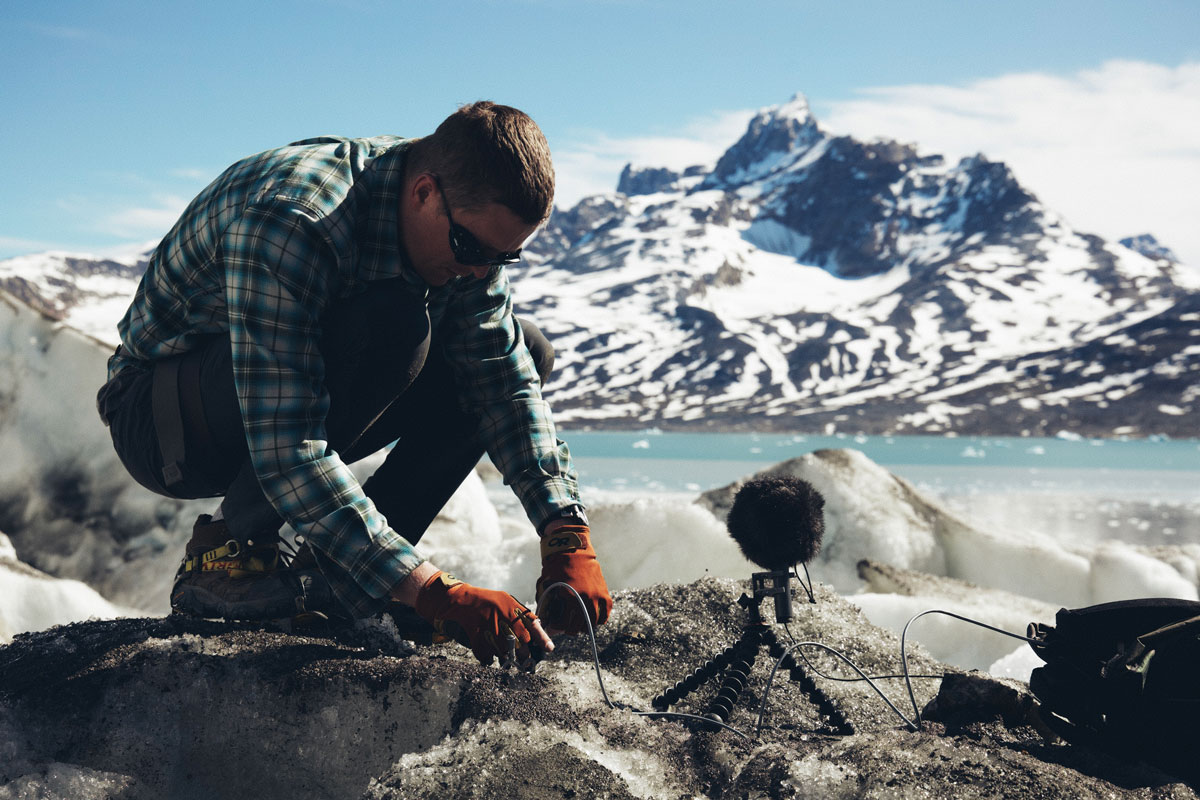
So, what’s next?
“I feel like I only scratched the surface of the wonderful world of glaciers, so I’m scheming for more expeditions in the future,” says Beverly. “I just love the polar regions in general, so I’m very interested in doing more glacier recordings in Patagonia, and maybe eventually in Antarctica, but there are lots more glaciers in Iceland and Greenland to explore as well. Finding how much sound happens on the glacier was a revelation to me. I was also quite surprised at the sounds produced by the underwater icebergs. That wasn’t something I was expecting to be as fascinating as it was.”

Recording stories so others can tell theirs
With Beverly’s field recordings used by Oscar, Emmy, and Golden Reel award winning sound designers and sound editors like Peter Albrechtson, Tim Farrell, Stephen Flick, Stuart McCowan, Robert Stambler, and Russell Topal among others, and companies, museums, and universities trusting in over 90 sound libraries from Thomas Rex Beverly Audio, his unique material offer a limitless canvas of opportunities for sound creatives.
“I have been very fortunate to work with some of the world’s renowned sound professionals and help them tell their stories with the sounds that I record. Whether it’s a blockbuster Movie, a nature documentary, a video game, or an art installation, the sound is the element that bonds the story together like a glue,” he concludes.

Beverly has just returned from Iceland, where he recorded more glacier sounds, ice caves and even electric storms in the spectacular phenomenon we know as the aurora borealis or the northern lights. There will be more great soundscapes to discover soon at https://thomasrexbeverly.com/.

